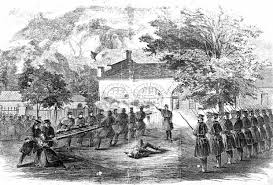
The road to the American Civil War was tumultuous and in some cases, bloody. At the center of antebellum violence was radical abolitionist, John Brown. He had been involved in the Bleeding Kansas conflict and even lead Free State forces in the infamous “Pottawatomie Massacre”. Brown was not afraid to shoot and kill in order to advance the cause of abolition. He believed that slavery was a national sin which would not be purged “but with blood”. He resolved to incite slaves to rebellion in Virginia and he hoped that this uprising would spread throughout the South and erase the ugly marks of slavery from the country.
John Brown’s plan was to seize the United States’ military arsenal at Harpers Ferry, Virginia and use the weapons he would capture to arm the slaves. Brown and a group of other abolitionists plotted to invade Harpers Ferry, which is now in West Virginia. They stayed in a farmhouse in Virginia while they prepared for the attack. Finally, they were poised to seize Harpers Ferry. They put the plan into motion in October 1859. They launched an attack into the town, seizing the railroad and cutting telegraph lines. By nightfall they had successfully taken the arsenal.
The next day, the local militia and townspeople surrounded the arsenal and forced John Brown’s party into the armory’s engine room which became known as “John Brown’s Fort”. In the course of the fighting, Brown lost several men including his own sons. President Buchanan called on the United States Marine Corps to go to Harpers Ferry and put down the insurrection. These forces were commanded by Robert E. Lee. (J.E.B. Stuart, another Confederate cavalry officer in the coming war, was also involved in fighting Brown in the raid.) When Lee arrived at the arsenal he ordered his men to attempt to negotiate Brown’s surrender. When this offer was refused, the Marines stormed the engine room and within a matter of minutes had captured the entire surviving raiding party.
The aftermath of the raid was pure fury in both the North and the South. To Northern abolitionists, Brown became a martyr and when he was hanged for treason, many rallied to his cause. In the South, however, Brown was seen as a vicious rebel and dangerous fanatic. The fears of slave revolts rose up again in the South and the two sides fought a verbal war over the legacy of the Harpers Ferry raid. Approximately one year after the raid on Harpers Ferry, Abraham Lincoln would be elected President and South Carolina would secede as a result. The Civil War was not far off. John Brown’s raid was hailed as heroism in the North and cursed as treason in the South. Regardless of what people said, the reality remained: blood had been spilled and the purge was soon to come.
